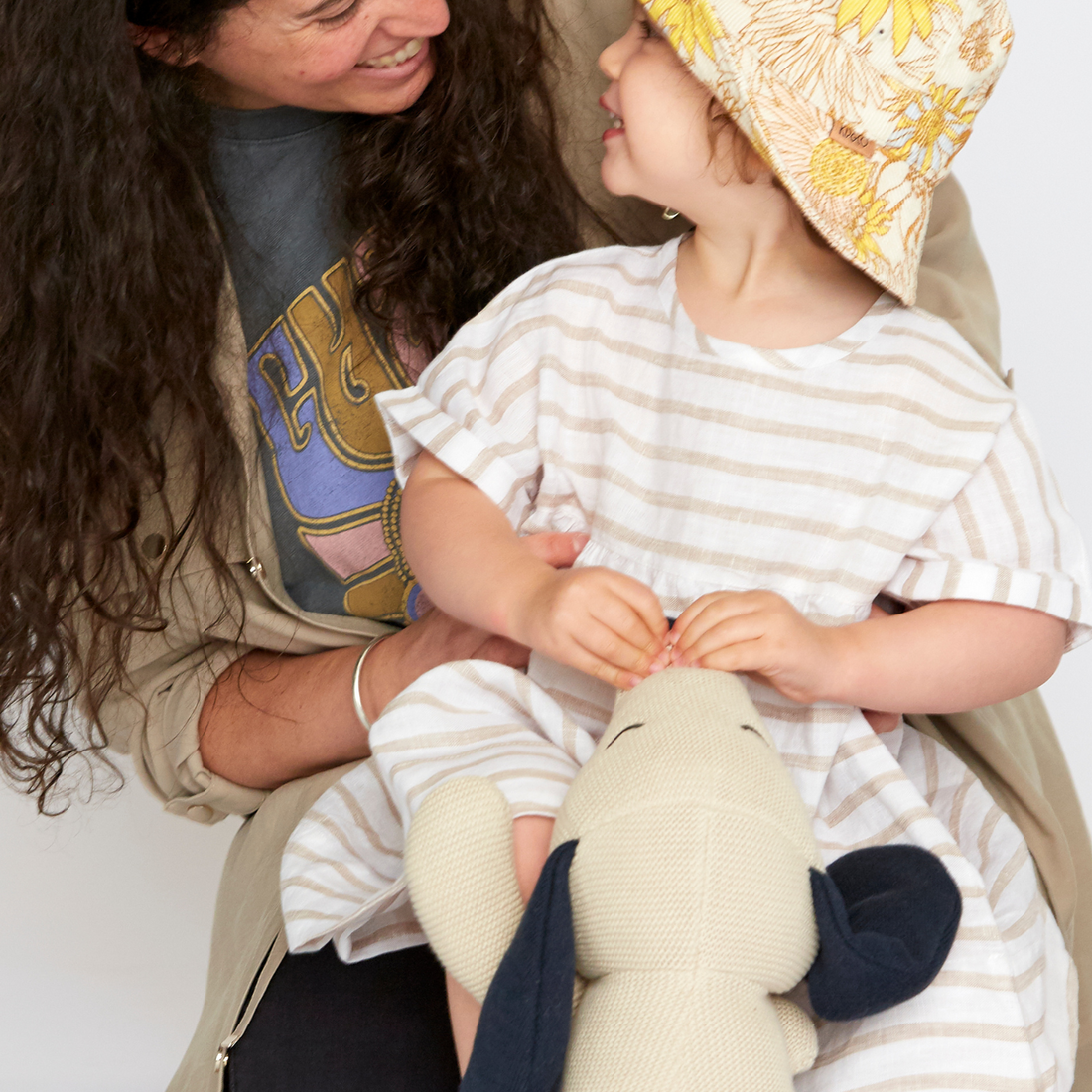Does your toddler play favourites? Only letting one parent put them to bed? Give them a bath? Peel their banana? It’s common, but tough. Tough for the non-preferred parent. Tough for the preferred parent. Tough on your relationship. Paediatric psychologist Amanda Abel has some advice on how to manage it.
Firstly, it’s a normal and common developmental phase for children to have a preferred parent, and as Abel points out, not a bad thing, “there’s an adaptive reason behind the selective nature of parental preference, we don’t want our children to accept ‘care’ from just anyone, so clinically speaking, it’s not a problem… but it can be challenging for families to manage on a practical level.”
The first step of managing your toddler playing favourites is understanding the reasons behind it.
A drive for independence and control
It is a human desire to seek agency and autonomy, but they have few opportunities to do so. Insisting on a certain parent to cut their sandwich gives them a chance to have more control over their world.
Secure attachment
“This can be influenced by the primary caregiver's role, especially if one parent spends more time with the child,” says Abel. “Routine and consistency can also play a part with children often showing preference for the parent who is more involved in their daily routines, providing them with a sense of security and stability. When their awareness is linked to separation anxiety, typically around 9-18 months, babies might cling more to the parent they see as their primary source of comfort and security.”
Temperament and personality
“Like in any relationship, sometimes a child’s temperament just aligns more with one parent,” says Abel. “There’s also the impact of parenting style, a child might gravitate towards the parent whose parenting style resonated with their current needs.” E.g. Seeking the parent who is more ‘nurturing’ when feeling upset, or the more ‘fun’ parent when feeling excited.
With the behaviour developmentally normal (and very understandable) for the child, the point where parental favouritism becomes problematic is when the situation is not viewed objectively by either parent. When the preferred parent can never get a break: has trouble leaving the house and is the one always on duty for bedtime, bathtime, nappy time, meal time…all-the-time, they can feel frustrated and exhausted. While the non-preferred parent, can struggle emotionally with feeling rejected. To get through it, Abel says for both parents, communication is key. “Like all things in a relationship and as co-parents, talking openly and honestly is absolutely key. Whether you’re the preferred or the non preferred parent the advice needs to start with you as a united team. The no.1 thing to do is ensuring both parents are on the same page with boundaries and rules, you need to be consistent and work together as children find it extremely challenging when they are sent mixed messages.” Children deserve to have a good relationship with both parents and seeing their parents working together and supporting each other is part of that.
What to do as the Non-Preferred parent
Be kind to yourself, but don’t take it personally
“While it can be hard, remind yourself not to take it personally,” says Abel. Rise above, and model unconditional love. “That way your emotions won’t get in the way of responding to your toddler. Acknowledging (and parking) your own emotional response is always essential before responding to your child’s emotions or behaviour.” If you do react emotionally with hurt or anger you’re much more likely to exacerbate the preference. The phase will pass quicker if your child isn’t getting anything out of it.
Be the calm, confident leader
It might feel easier to give into your child's demands, but that is giving them more power than they are developmentally ready for. Young children feel safer knowing that they are in the hands of calm and confident leaders who love them unconditionally while holding limits. Try something like, “I know you really want daddy to take you to school, but he can't do it today. I know you feel disappointed."
Validate their feelings
Empathise and show you understand their frustrations. ‘I know you want mum to put you to bed because you really enjoy that time with her. I’m doing bedtime tonight, but how about we use mum’s dressing gown as an extra blanket for you so it feels a bit more like she’s here?! Would I look funny if I wore mum’s dressing gown?!’ Abel says a little humour can help redirect your child, “just make sure you’ve acknowledged their feelings first so you’re not simply trying to get them to snap out of their emotional experience.” And no sarcasm.
Expect push-backs, stay strong
We can’t expect children to accept our limits, and that’s OK. When they reject you, try giving them a choice (in which the preferred parent is not an option), “I can read you books tonight or we can just go to bed”. You could also just start doing the task in a way that will appeal to them e.g. reading their favourite book aloud in a funny voice. Again, humour, fun and staying upbeat is a big winner for kids.
Build the positive one-on-one time bank
Usually, when the preferred parent is out of the picture, and there's no choice and the non preferred status dissolves and the child becomes just fine with them. So, be intentional in setting up one-on-one time to create a bigger bank of positive experiences together. Start out with fun activities, like going on dates or to their favourite places like the zoo.
Create your rituals
“If you are not the primary carer, or not at home regularly,” says Abel, “you can create domestic rituals when you are, like cooking, gardening or shopping together. These will help with the collective family load and give you quality time together.”
Show the union
Showing your kids that their parents are a team can also help in the moment. Many parents have had success consoling children wanting the other parent with validation, empathy and a little redirection. For example, “I know you want mummy to get you dressed, mummy is so good at it. I’m going to do it today, but should we sing her happy song?”
What to do as the Non-Preferred parent
Be kind to yourself, but don’t take it personally
While flattering, though exhausting, adjust your lens and see the preference for what it is, a developmental phase. Your child isn’t trying to manipulate you, you shouldn’t feel guilty or sad when you do or don’t do what they want you to, but also acknowledge how the preference makes you feel (be it pride, distress or anger) and make sure those things don’t come through in your reactions to them.
Be the firm, confident leader
It is important for you, your child and your co-parent, that when the non preferred parent is doing something, that you hold your ground and do not step in. You can briefly, positively explain to them why you can’t do whatever it is that they want you to and that their other parent is doing it instead, then move on. Don’t wait for them to like the idea. How you act in these moments will send a strong message to your child of how to understand the situation.
Validate their feelings
For both parents, it’s important you show that you understand their feelings. Let them express themselves and don’t cut them off for fear of them upsetting the other parent. All feelings are allowed and should be heard.
Share the fun
If you are the parent who gets to do more of what you child considers fun: park visits, play, cuddles, etc. while your co-parent is more of the other stuff: dinner, bath, bed. Think about how you could more evenly divide things, or make the basic things more fun. If you’re the primary carer, you’re picking up more parenting tricks and learning more about your child’s preferences and personality. It’s OK to share these things with your co-parent. It doesn’t have to feel like you telling them how to parent, but it’s never a bad thing to keep them in the loop. Abel suggests starting small and together. “To encourage the bedtime routine with the non-preferred parent, start with small, positive interactions during the day (it could be a FaceTime if they aren’t at home), as well as at bedtime. For instance, the preferred parent can begin the bedtime routine, and the ‘non-preferred parent’ can join for a part of it, such as reading a story or saying goodnight. Making bedtime more fun with the ‘non-preferred parent’ can help, and this can involve incorporating special activities, like reading a favourite book, singing a lullaby, or talking about the day’s highlights.”
Show the union and talk up your co-parent
Abel says it’s so important in shifting the dynamic to work together, “Stay consistent with the boundaries and rules you’ve created as a family.” Show your support of your co-parent, e.g. “How great is it that daddy is picking you up today!”
Amanda Abel is a paediatric psychologist, mum, founder of the Northern Centre for Child Development (NCCD) and co-creator of the Toddler Toolkit alongside Dr Golly. Working directly and indirectly with hundreds of clients each year, Amanda’s mission is for every child to achieve their best outcomes by equipping families and educators with the tools they need to help kids thrive. Amanda draws on her own experiences of being a parent along with her extensive training and well-honed skill set to get families thriving. She is Circle of Security Parenting® trained and is a registered SOS Feeding Therapist for children who are problem feeders.
Find her on Instagram: @amandaabel @toddlertoolkit
The Toddler Toolkit is an online parenting course for 1-5 year olds helping parents navigate every toddler stage and challenge RRP $100.








































































































